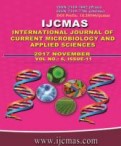


 National Academy of Agricultural Sciences (NAAS)
National Academy of Agricultural Sciences (NAAS)

|
PRINT ISSN : 2319-7692
Online ISSN : 2319-7706 Issues : 12 per year Publisher : Excellent Publishers Email : editorijcmas@gmail.com / submit@ijcmas.com Editor-in-chief: Dr.M.Prakash Index Copernicus ICV 2018: 95.39 NAAS RATING 2020: 5.38 |
Experiments conducted on the seasonal incidence of Pieris brassicae L. during 2014-2015 and 2015- 2016 at the University Farm of Sher-e-Kashmir University of Agricultural Sciences and Technology- Jammu revealed that P. brassicae were first observed in the 43rd standard week (1.33 larvae plant-1) and lowest population of 0.12 larvae per plant during the 15th standard week. The P. brassicae population was maximum (5.74 larvae plant-1) in 7th standard week, respectively. The maximum and minimum temperature showed significant negative correlation with r values (r = - 0.545** and r = - 0.631**), while relative humidity (morning) had a positive and highly significant effect with r value (r = 0.622**) impact on larval population. Whereas relative humidity (evening) and rainfall had no significant effect with r value (r = 0.162 and r = - 0.205) on the larval population. Regression studies revealed that the weather factors had 45.30 per cent contribution towards larval population. The relative efficacy of insect growth regulators against the cabbage white butterfly, P. brassicae showed that fenvalerate had higher efficacy against P. brassicae in reducing pest population. Mean population of P. brassicae after two sprays revealed that fenvalerate 0.004% was effective and superior. The next best were lufenuron 0.006% and novaluran 0.100% which were at par. chlorfenapyr 0.150% was found to be least effective against P. xylostella.
 |
 |
 |
 |
 |